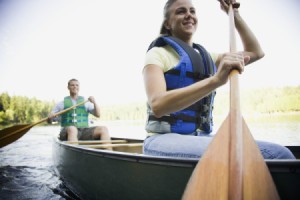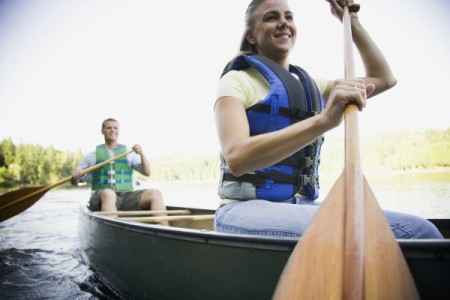 Canoes have a natural tendency to drift to one side rather than move forward in a straight line. This can be incredibly frustrating to new paddlers who have never been given any basic instruction. The secret to steering a canoe is to minimize (not eliminate) that tendency to drift when you want to go straight and to use it to your advantage when you want the canoe to turn. A canoe will NEVER paddle in an absolute straight line, so it's best to let go of that expectation before you even get on the water!
Canoes have a natural tendency to drift to one side rather than move forward in a straight line. This can be incredibly frustrating to new paddlers who have never been given any basic instruction. The secret to steering a canoe is to minimize (not eliminate) that tendency to drift when you want to go straight and to use it to your advantage when you want the canoe to turn. A canoe will NEVER paddle in an absolute straight line, so it's best to let go of that expectation before you even get on the water!

In a tandem canoe (two-person canoe), paddling is a team effort and communication is key to successfully steering the canoe. The stern paddler (sternman) always has more leverage than the bow paddler (bowman). So even when two people are paddling on opposing sides, the canoe will always drift slightly away from the side the stern person is paddling on (e.g. if the stern person is paddling on the right, canoe will drift slightly to the left).
In most cases, the stronger, more experienced paddler should be seated at the stern, and give instructions as needed to the person at the bow. The sternman is able to see and speak to the bowman more easily than the reverse. If the bowman sees an obstacle ahead, he or she should alert the sternman, instead of taking a sudden, independent action of their own.
There are more than a dozen types of strokes you can use to paddle a tandem canoe. In nearly all cases, however, you can control a canoe using just four basic strokes: the forward stroke, backward stroke, small sweep, or J-stroke, and the draw stroke.
Making the canoe move forward or backward can be accomplished by performing two basic strokes.
Forward stroke: Paddle forward simultaneously on opposing sides of the hull. Each stroke is synchronizedstarting and finishing togetherwith with the same duration and pacing. The forward stroke causes the canoe to go straight forward (well, almost straight forward) and remain stable in the water. To keep the canoe from wandering, the paddlers switch sides often by using an oral signal (hup or switch) upon which both paddlers switch sides in unison.
Because a canoe always tends to drift away from the stern-paddling side, the sternman may also elect to do a small extra stroke every 3 to 5 strokes, on whatever side is appropriate, to maintain a straight course. How often depends on the canoe, the strength of each paddler, and the conditions (wind, waves, etc.). On larger bodies of water, its also helpful to aim for a target across the lake (tree, rock, cabin, etc.) to help maintain a straight course.
Backward stroke: Paddle in reverse, simultaneously on opposing sides of the hull, to make the canoe go backward.
Making a canoe turn is easy by taking advantage of its natural tendency to drift. For example, if you want the canoe to turn left, have the bowman paddle on the left side while the sternman paddles on the right. This sets up the canoe to slowly drift left. To steer a canoe to the right, do the opposite.
Sweep or J-stroke: If you need to accelerate turning, try using the sweep stroke. Usually performed by the sternman alone, this stroke causes the canoe to turn strongly away from the stern-paddling side. The stroke begins near the hull, and instead of the paddle being pulled straight back, it sweeps outward, and then back in, making a 90 degree arc. The bowman keeps paddling normally, and the sternman continues to perform as many sweep strokes as needed to get the desired result.
Another method used to turn a canoe is for both paddlers to paddle on the same side. Both can perform standard forward strokes, or one or both can perform sweep strokes, depending upon how rapidly you need to turn. For example, if both paddlers perform sweep strokes on the right side of the canoe, the canoe will turn strongly to the left.
A final method for turning a canoe is for the bowman to stop paddling while the sternman keeps paddling. The canoe will then turn away from whatever side the sternman is paddling on. The only problem with this method is the fact that one paddler has to do all the work. Although seldom used, this strategy can be an effective way to maneuver the canoe through slow, tight areas.
Draw stroke: This stroke is used for turning a canoe that has stopped. With draw strokes, the canoe can be spun around its center, and pointed in a new direction. To perform a draw stroke, paddlers reach straight out from the canoe on opposing sides and use their paddle to pull the water directly toward the canoe. This stroke should be done with the canoe at rest or moving slowly because it causes a very sharp turn which is unstable at higher speeds. The draw stroke isnt used often, but it is valuable in threatening situations when you need to aim your canoe away from trouble and make a quick escape.
To keep a solo (one-person) canoe on a straight course, the paddler must switch sides almost constantly. Since the solo paddler is seated near the pivot point of the hull, and there is no opposing paddler for balance, a solo canoe drifts strongly away from the paddling side.
While paddlers in a tandem canoe might switch sides every eight-to-twelve strokes (more or less), in a solo canoe it may be every five strokes or fewer. To turn a solo canoe, use the same basic sweep or draw strokes, but expect a faster, sharper response.
This page contains the following solutions.
Steering a canoe efficiently can cause quite a bit of frustration for the novice canoeist. The best advice is to do a little as possible and when you do need to correct the course, do it with the least amount of effort.